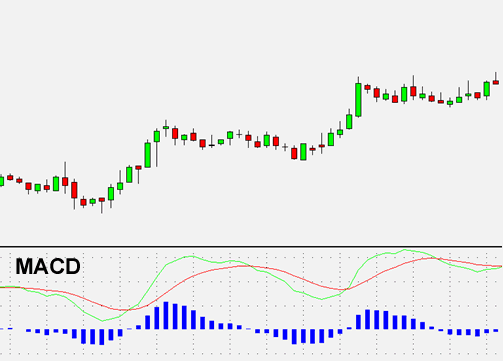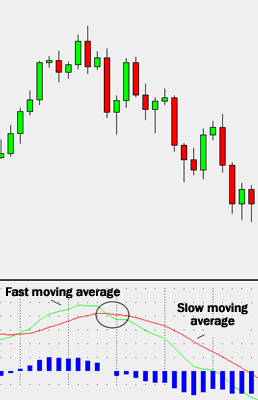MACD
MACD is an acronym for
Moving Average
Convergence
Divergence. This tool
is used to identify moving averages sthat
are indicating a new trend, whether it’s bullish or bearish. After all,
our #1 priority in trading is being able to find
a trend, because that is where the most money is made. .

With an MACD chart, you will usually see three numbers that
are used for its settings.
- The first is the number of periods that is used to
calculate the faster moving average.
- The second is the number of periods that are used in the
slower moving average.
- And the third is the number of bars that is used to
calculate the moving average of the difference between the
faster and slower moving averages.
For example, if you were to see “12,26,9” as the MACD
parameters (which is usually the default setting for most
charting packages), this is how you would interpret it:
- The 12 represents the previous 12 bars of the faster
moving average.
- The 26 represents the previous 26 bars of the slower
moving average.
- The 9 represents the previous 9 bars of the difference
between the two moving averages. This is plotted by
vertical lines called a histogram (The blue lines in the
chart above).
There is a common misconception when it comes to the lines
of the MACD. The two lines that are drawn are NOT moving
averages of the price. Instead, they are the moving
averages of the DIFFERENCE between two moving averages.
In our example above, the faster moving average is the
moving average of the difference between the 12 and 26 period
moving averages. The slower moving average plots the average
of the previous MACD line. Once again, from our example above,
this would be a 9 period moving average.
This means that we are taking the average of the last 9
periods of the faster MACD line, and plotting it as our
“slower” moving average. What this does is it smoothes out the
original line even more, which gives us a more accurate line.
The histogram simply plots the difference between the fast
and slow moving average. If you look at our original
chart, you can see that as the two moving averages separate,
the histogram gets bigger. This is called divergence,
because the faster moving average is “diverging” or moving
away from the slower moving average.
As the moving averages get closer to each other, the
histogram gets smaller. This is called convergence
because the faster moving average is “converging” or getting
closer to the slower moving average. And that, my friend, is
how you get the name, Moving
Average Convergence
Divergence! Whew, we need to crack our
knuckles after that one!
MACD Crossover
Because there are two moving averages with different
“speeds”, the faster one will obviously be quicker to react to
price movement than the slower one. When a new trend
occurs, the fast line will react first and eventually cross
the slower line. When this “crossover” occurs, and the
fast line starts to “diverge” or move away from the slower
line, it often indicates that a new trend has formed.

From the chart above, you can see that the fast line
crossed under the slow line and correctly identified a new
downtrend. Notice that when the lines crossed, the histogram
temporarily disappears. This is because the difference between
the lines at the time of the cross is 0. As the
downtrend begins and the fast line diverges away from the slow
line, the histogram gets bigger, which is good indication of a
strong trend.
There is one drawback to MACD. Naturally, moving
averages tend to lag behind price. After all, it's just
an average of historical prices. Since the MACD represents
moving averages of other moving averages and
is smoothed out by another moving average, you can imagine
that there is quite a bit of lag. However, it is still one of
the most favored tools by many traders.
|